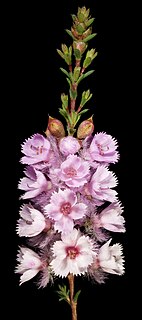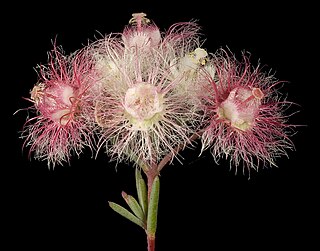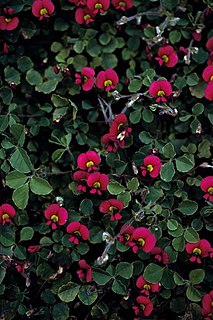
Chorilaena quercifolia, commonly known as karri oak or chorilaena, is a species of bushy shrub that is endemic to the karri forests of south-west Western Australia. It is the sole species in the genus Chorilaena. It has papery, broadly egg-shaped leaves with lobed edges and variously-coloured flowers arranged in umbels of five, the sepals and petals hairy on the outside and the stamens protruding beyond the petals.

Melaleuca huegelii, commonly known as chenille honey-myrtle, is a plant in the myrtle family, Myrtaceae and is endemic to the south-west coastal areas of Western Australia. It has small, almost scale-like leaves and flower spikes sometimes more than 100 millimetres (4 in) long on the ends many of its branches.

Verticordia insignis is a species of flowering plant in the myrtle family, Myrtaceae and is endemic to the south-west of Western Australia. It is an open, irregularly-branched shrub with small leaves and heads of relatively large pink, or white and pink flowers on the ends of the branches in spring.

Darwinia citriodora, commonly known as lemon-scented darwinia or lemon scented myrtle, is a plant in the myrtle family Myrtaceae and is endemic to the south-west of Western Australia. It is a shrub with oblong to lance-shaped leaves and red, yellow and orange flowers over an extended period. It is a hardy plant in well-drained soil, is often cultivated and used as a rootstock for less hardy species.

Verticordia pennigera, commonly known as native tea, is a flowering plant in the myrtle family, Myrtaceae, and is endemic to the south-west of Western Australia. It is usually a small erect or prostrate shrub with small leaves and lightly-scented spikes of pale pink to magenta-coloured flowers in spring.

Acacia huegelii is a shrub belonging to the genus Acacia and the subgenus Phyllodineae native to Western Australia.

Verticordia huegelii var. huegelii, commonly known as variegated featherflower, is a flowering plant in the myrtle family, Myrtaceae and is endemic to the south-west of Western Australia. It is an upright, slender or bushy shrub, with creamish-white flowers turning pink or reddish maroon as they age, giving the plant a variegated appearance. It is similar to Verticordia huegelii var. decumbens but is more upright than that variety and lacks a lignotuber.

Verticordia huegelii var. decumbens, commonly known as variegated featherflower, is a flowering plant in the myrtle family, Myrtaceae and is endemic to the south-west of Western Australia. It is an almost prostrate shrub, with creamish-lemon coloured flowers turning pink then red as they age, giving the plant a variegated appearance. It is similar to Verticordia huegelii var. huegelii but has a lignotuber and a lower growth habit.
Verticordia huegelii var. tridens, commonly known as variegated featherflower, is a flowering plant in the myrtle family, Myrtaceae and is endemic to the south-west of Western Australia. It is a slender, open, sometimes straggly shrub with bright yellow flowers which age to red and then brown and differently-shaped staminodes from the other varieties of the species.
Hemiandra linearis, commonly known as speckled snakebush, is a species of prostrate to ascending shrub that is endemic to the south-west of Western Australia.

Goodenia fasciculata is a species of flowering plant in the family Goodeniaceae and is endemic to the south-west of Western Australia. It an ascending shrub with bunched, narrow linear stem leaves and spikes of white flowers.

Hibbertia huegelii is a species of flowering plant in the family Dilleniaceae and is endemic to the south-west of Western Australia. It is an erect, spreading or prostrate shrub with hairy branchlets, linear leaves and yellow flowers arranged singly in leaf axils on the ends of shoots, with fifteen to twenty-five stamens in bundles around the four or five carpels.

Hibbertia perfoliata is a species of flowering plant in the family Dilleniaceae and is endemic to Western Australia. It is a weak, ascending or prostrate, spreading shrub that typically grows to a height of up to 40 cm (16 in). It flowers from September to December or from January to March and has yellow flowers. The species was first formally described in 1837 by Stephan Endlicher from an unpublished description by Charles von Hügel and Endlicher's description was published in his book Enumeratio plantarum quas in Novae Hollandiae ora austro-occidentali ad fluvium Cygnorum et in sinu Regis Georgii collegit Carolus Liber Baro de Hügel. The specific epithet (perfoliata) means "perfoliate".

Kennedia carinata is a species of flowering plant in the family Fabaceae and is endemic to the south-west of Western Australia. It is a prostrate shrub with trifoliate leaves and reddish-purple, pea-like flowers.

Lechenaultia floribunda, commonly known as free-flowering leschenaultia, is a species of flowering plant in the family Goodeniaceae and is endemic to the south-west of Western Australia. It is an openly-branched shrub or subshrub with crowded, narrow, fleshy leaves and compact groups of pale blue to pale mauve or creamy white flowers.
Lasiopetalum cordifolium, is a species of flowering plant in the family Malvaceae and is endemic to the south-west of Western Australia. It is an erect shrub with hairy stems, heart-shaped leaves and pink, cream-coloured or white flowers.

Sphaerolobium alatum is a species of flowering plant in the family Fabaceae and is endemic to the south of Western Australia. It is a slender, leafless shrub with yellow and reddish-brown flowers from September to November.
Sphaerolobium fornicatum is a species of flowering plant in the family Fabaceae and is endemic to the far south-west of Western Australia. It is a leafless shrub that typically grows to a height of 0.1–1 m and has yellow or orange and red flowers from October to January.

Sphaerolobium grandiflorum is a species of flowering plant in the family Fabaceae and is endemic to the south of Western Australia. It is an erect, slender, leafless shrub with red, yellow and orange flowers.

Sphaerolobium linophyllum is a species of flowering plant in the family Fabaceae and is endemic to the south of Western Australia. It is a prostrate to ascending shrub with a few narrowly linear leaves and red, yellow and orange flowers.

















